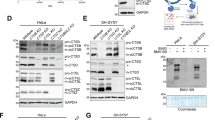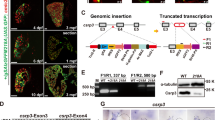Abstract
Spf1p is a P-type ATPase that is mainly localized to the endoplasmic reticulum (ER) in Saccharomyces cerevisiae. The protein is involved in the maintenance of ion homeostasis in the ER. To investigate the intracellular role of Spf1p in more detail, we performed a genetic screen for mutations that lead to synthetic lethality in combination with a disruption of SPF1; the mutations identified have been termed lws (for lethal with spf1) mutations. Mutant alleles of five LWS genes (MDM39, RIC1, LAS21, TUP1 and BTS1) were recovered. The identification of these genes provides clues to the physiological relationships between Spf1p function and the secretory pathway. Among the five genes identified, MDM39 encodes a membrane protein that is similar to the protein CHD5/WRB, which is involved in the pathogenesis of Down syndrome-associated congenital heart disease in humans. We localized Mdm39p to the ER. The Δmdm39 mutant exhibited defects in glycosylation, cell wall organization and the unfolded protein response. It also showed calcium-related phenotypes and synthetic lethal interactions with deletion mutations in other LWS genes. Our findings imply a homeostatic role for Mdm39p, which may be related to the regulation of calcium ion fluxes in the ER, and is indispensable for mutants that lack Spf1p.




Similar content being viewed by others
References
Axelsen KB, Palmgren MG (1998) Evolution of substrate specificities in the P-type ATPase superfamily. J Mol Evol 46:84–101
Bateman A, Coin L, Durbin R, Finn RD, Hollich V, Griffiths-Jones S, Khanna A, Marshall M, Moxon S, Sonnhammer EL, Studholme DJ, Yeats C, Eddy SR (2004) The Pfam protein families database. Nucleic Acids Res Database Issue 32:D138–D141
Benachour A, Sipos G, Flury I, Reggiori F, Canivenc-Gansel E, Vionnet C, Conzelmann A, Benghezal M (1999) Deletion of GPI7, a yeast gene required for addition of a side chain to the glycosylphosphatidylinositol (GPI) core structure, affects GPI protein transport, remodeling, and cell wall integrity. J Biol Chem 274:15251–15261
Bender A, Pringle JR (1991) Use of a screen for synthetic lethal and multicopy suppressee mutants to identify two new genes involved in morphogenesis in Saccharomyces cerevisiae. Mol Cell Biol 11:1295–1305
Bensen ES, Yeung BG, Payne GS (2001) Ric1p and the Ypt6p GTPase function in a common pathway required for localization of trans-Golgi network membrane proteins. Mol Biol Cell 12:13–26
Bonangelino CJ, Chavez EM, Bonifacino JS (2002) Genomic screen for vacuolar protein sorting genes in Saccharomyces cerevisiae. Mol Biol Cell 13:2486–2501
Burke D, Dawson D, Stearns T (2000) Methods in yeast genetics. Cold Spring Harbor Laboratory Press, Cold Spring Harbor, NY
Cormack BP, Bertram G, Egerton M, Gow NA, Falkow S, Brown AJ (1997) Yeast-enhanced green fluorescent protein (yEGFP), a reporter of gene expression in Candida albicans. Microbiology 143:303–311
Cox JS, Walter P (1996) A novel mechanism for regulating activity of a transcription factor that controls the unfolded protein response. Cell 87:391–404
Cronin SR, Khoury A, Ferry DK, Hampton RY (2000) Regulation of HMG-CoA reductase degradation requires the P-type ATPase Cod1p/Spf1p. J Cell Biol 148:915–924
Cronin SR, Rao R, Hampton RY (2002) Cod1p/Spf1p is a P-type ATPase involved in ER function and Ca2+ homeostasis. J Cell Biol 157:1017–1028
Dean N (1995) Yeast glycosylation mutants are sensitive to aminoglycosides. Proc Natl Acad Sci USA 92:1287–1291
DeRisi JL, Iyer VR, Brown PO (1997) Exploring the metabolic and genetic control of gene expression on a genomic scale. Science 278:680–686
Dimmer KS, Fritz S, Fuchs F, Messerschmitt M, Weinbach N, Neupert W, Westermann B (2002) Genetic basis of mitochondrial function and morphology in Saccharomyces cerevisiae. Mol Biol Cell 13:847–853
Dürr G, Strayle J, Plemper R, Elbs S, Klee SK, Catty P, Wolf DH, Rudolph HK (1998) The medial-Golgi ion pump Pmr1 supplies the yeast secretory pathway with Ca2+ and Mn2+ required for glycosylation, sorting, and endoplasmic reticulum-associated protein degradation. Mol Biol Cell 9:1149–1162
Egeo A, Mazzocco M, Sotgia F, Arrigo P, Oliva R, Bergonon S, Nizetic D, Rasore-Quartino A, Scartezzini P (1998) Identification and characterization of a new human cDNA from chromosome 21q22.3 encoding a basic nuclear protein. Hum Genet 102:289–293
Enyenihi AH, Saunders WS (2003) Large-scale functional genomic analysis of sporulation and meiosis in Saccharomyces cerevisiae. Genetics 163:47–54
Gietz RD, Sugino A (1988) New yeast– Escherichia coli shuttle vectors constructed with in vitro mutagenized yeast genes lacking six-base pair restriction sites. Gene 74:527–534
Guthrie C, Fink GR (1991) Guide to yeast genetics and molecular biology. Methods Enzymol 194:149–165
Heinisch JJ, Lorberg A, Schmitz H-P, Jacoby JJ (1999) The protein kinase C-mediated MAP kinase pathway involved in the maintenance of cellular integrity in Saccharomyces cerevisiae. Mol Microbiol 32:671–680
Horie T, Isono K (2001) Cooperative functions of the mannoprotein-encoding genes in the biogenesis and maintenance of the cell wall in Saccharomyces cerevisiae. Yeast 18:1493–1503
Huh WK, Falvo JV, Gerke LC, Carroll AS, Howson RW, Weissman JS, O’Shea EK (2003) Global analysis of protein localization in budding yeast. Nature 425:686–691
Jiang Y, Proteau P, Poulter D, Ferro-Novick S (1995) BTS1 encodes a geranylgeranyl diphosphate synthase in Saccharomyces cerevisiae. J Biol Chem 270:21793–21799
Kaufman RJ (1999) Stress signaling from the lumen of the endoplasmic reticulum: coordination of gene transcriptional and translational controls. Genes Dev 13:1211–1233
Kawahara T, Yanagi H, Yura T, Mori K (1997) Endoplasmic reticulum stress-induced mRNA splicing permits synthesis of transcription factor Hac1p/Ern4p that activates the unfolded protein response. Mol Biol Cell 8:1845–1862
Knop M, Siegers K, Pereira G, Zachariae W, Winsor B, Nasmyth K, Schiebel E (1999) Epitope tagging of yeast genes using a PCR-based strategy: more tags and improved practical routines. Yeast 15:963–972
Nakayama K, Nagasu T, Shimma Y, Kuromitsu J, Jigami Y (1992) OCH1 encodes a novel membrane bound mannosyltransferase: outer chain elongation of asparagine-linked oligosaccharides. EMBO J 11:2511–2519
Patil C, Walter P (2001) Intracellular signaling from the endoplasmic reticulum to the nucleus: the unfolded protein response in yeast and mammals. Curr Opin Cell Biol 13:349–355
Pringle JR, Adams AE, Drubin DG, Haarer BK (1991) Immunofluorescence methods for yeast. Methods Enzymol 194:565–602
Ram AF, Wolters A, Ten Hoopen R, Klis FM (1994) A new approach for isolating cell wall mutants in Saccharomyces cerevisiae by screening for hypersensitivity to Calcofluor white. Yeast 10:1019–1030
Sambrook J, Fritsch EF, Maniatis T (1989) Molecular cloning: a laboratory manual, 2nd edn. Cold Spring Harbor Laboratory, Cold Spring Harbor, NY
Shimma Y, Nishikawa A, bin Kassim B, Eto A, Jigami Y (1997) A defect in GTP synthesis affects mannose outer chain elongation in Saccharomyces cerevisiae. Mol Gen Genet 256:469–480
Siniossoglou S, Pelham HR (2001) An effector of Ypt6p binds the SNARE Tlg1p and mediates selective fusion of vesicles with late Golgi membranes. EMBO J 20:5991–5998
Siniossoglou S, Peak-Chew SY, Pelham HR (2000) Ric1p and Rgp1p form a complex that catalyses nucleotide exchange on Ypt6p. EMBO J 19:4885–4894
Strayle J, Pozzan T, Rudolph HK (1999) Steady-state free Ca2+ in the yeast endoplasmic reticulum reaches only 10 mM and is mainly controlled by the secretory pathway pump Pmr1. EMBO J 18:4733–4743
Suzuki C (2001) Immunochemical and mutational analyses of P-type ATPase Spf1p involved in the yeast secretory pathway. Biosci Biotechnol Biochem 65:2405–2411
Suzuki C (2004) Acidophilic structure and killing mechanism of the Pichia farinosa killer toxin SMKT. Top Curr Genet 11:189–214
Suzuki C, Nikkuni S (1994) The primary and subunit structure of a novel type killer toxin produced by a halotolerant yeast, Pichia farinosa. J Biol Chem 269:3041–3046
Suzuki C, Shimma Y (1999) P-type ATPase spf1 mutants show a novel resistance mechanism for the killer toxin SMKT. Mol Microbiol 32:813–823
Tipper DJ, Harley CA (2002) Yeast genes controlling responses to topogenic signals in a model transmembrane protein. Mol Biol Cell 13:1158–1174
Tokunaga M, Kato S, Kawamura-Watabe A, Tanaka R, Tokunaga H (1998) Characterization of deletion mutations in the carboxy-terminal peptide-binding domain of the Kar2 protein in Saccharomyces cerevisiae. Yeast 14:1285–1295
Tong AH, Evangelista M, Parsons AB, Xu H, Bader GD, Page N, Robinson M, Raghibizadeh S, Hogue CW, Bussey H, Andrews B, Tyers M, Boone C (2001) Systematic genetic analysis with ordered arrays of yeast deletion mutants. Science 294:2364–2368
Tong AH et al (2004) Global mapping of the yeast genetic interaction network. Science 303:808–813
Travers KJ, Patil CK, Wodicka L, Lockhart DJ, Weissman JS, Walter P (2000) Functional and genomic analyses reveal an essential coordination between the unfolded protein response and ER-associated degradation. Cell 101:249–258
Vashist S, Frank CG, Jakob CA, Ng DT (2002) Two distinctly localized P-type ATPases collaborate to maintain organelle homeostasis required for glycoprotein processing and quality control. Mol Biol Cell 13:3955–3966
Vidal-Taboada JM, Bergonon S, Sanchez M, Lopez-Acedo C, Groet J, Nizetic D, Egeo A, Scartezzini P, Katsanis N, Fisher EM, Delabar JM, Oliva R (1998) High resolution physical mapping and identification of transcribed sequences in the Down syndrome region-2. Biochem Biophys Res Commun 243:572–578
Winzeler EA et al (1999) Functional characterization of the S. cerevisiae genome by gene deletion and parallel analysis. Science 285:901–906
Acknowledgements
This work was supported in part by the Cooperative System for Supporting Priority Research of the Japan Science and Technology Agency. We thank Dr K. Isono for providing yeast strains, Dr Y. Ohya for providing the yeast genomic library, Drs. R.D. Gietz, J.H. Hegemann, K. Mori, Y. Noda and E. Schiebel for providing plasmids, Dr M. Tokunaga for providing antibodies, and Dr J. Shima for participating in critical discussions.
Author information
Authors and Affiliations
Corresponding author
Additional information
Communicated by D. Thomas
Rights and permissions
About this article
Cite this article
Ando, A., Suzuki, C. Cooperative function of the CHD5-like protein Mdm39p with a P-type ATPase Spf1p in the maintenance of ER homeostasis in Saccharomyces cerevisiae. Mol Genet Genomics 273, 497–506 (2005). https://doi.org/10.1007/s00438-005-1153-6
Received:
Accepted:
Published:
Issue Date:
DOI: https://doi.org/10.1007/s00438-005-1153-6




